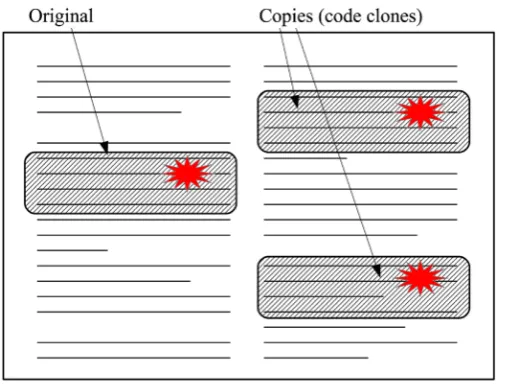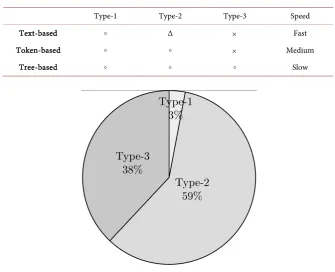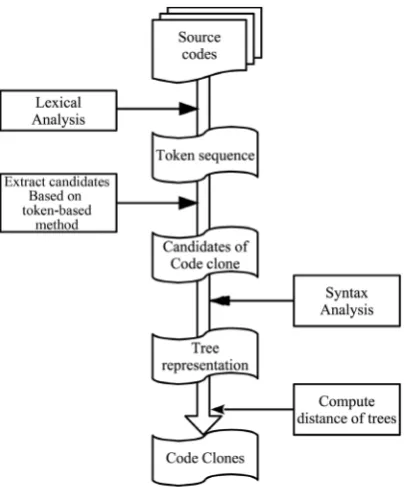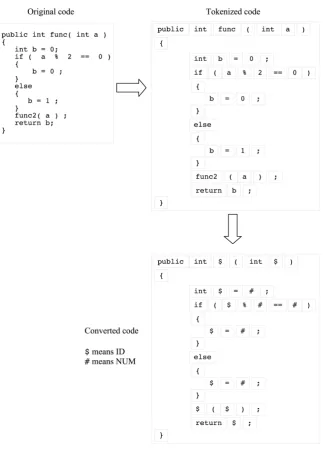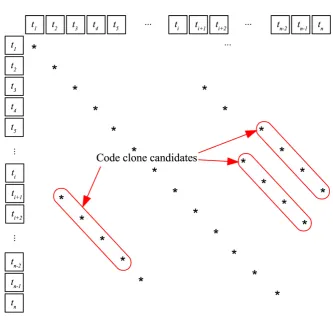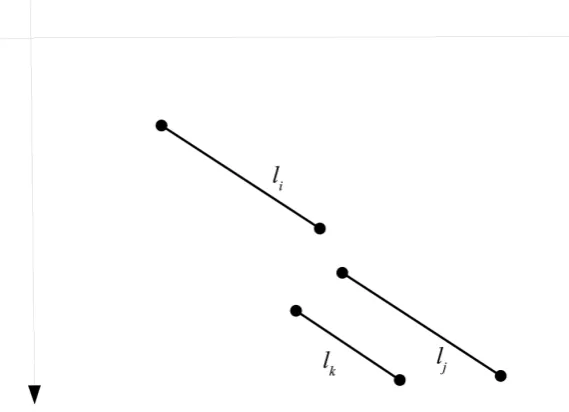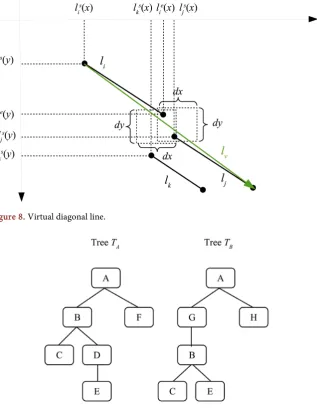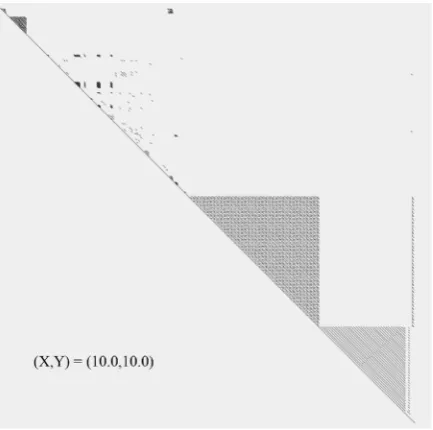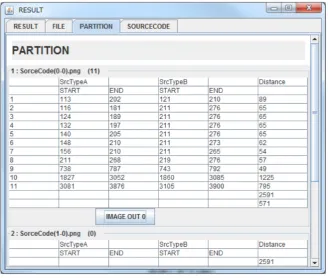ISSN Online: 1945-3124 ISSN Print: 1945-3116
DOI: 10.4236/jsea.2017.1013051 Dec. 28, 2017 891 Journal of Software Engineering and Applications
Code Clone Detection Method Based on the
Combination of Tree-Based and Token-Based
Methods
Ryota Ami, Hirohide Haga
Graduate School of Science and Engineering, Doshisha University, Kyoto, Japan
Abstract
This article proposes the high-speed and high-accuracy code clone detection method based on the combination of tree-based and token-based methods. Existence of duplicated program codes, called code clone, is one of the main factors that reduces the quality and maintainability of software. If one code fragment contains faults (bugs) and they are copied and modified to other lo-cations, it is necessary to correct all of them. But it is not easy to find all code clones in large and complex software. Much research efforts have been done for code clone detection. There are mainly two methods for code clone detec-tion. One is token-based and the other is tree-based method. Token-based method is fast and requires less resources. However it cannot detect all kinds of code clones. Tree-based method can detect all kinds of code clones, but it is slow and requires much computing resources. In this paper combination of these two methods was proposed to improve the efficiency and accuracy of detecting code clones. Firstly some candidates of code clones will be extracted by token-based method that is fast and lightweight. Then selected candidates will be checked more precisely by using tree-based method that can find all kinds of code clones. The prototype system was developed. This system ac-cepts source code and tokenizes it in the first step. Then token-based method is applied to this token sequence to find candidates of code clones. After ex-tracting several candidates, selected source codes will be converted into ab-stract syntax tree (AST) for applying tree-based method. Some sample source codes were used to evaluate the proposed method. This evaluation proved the improvement of efficiency and precision of code clones detecting.
Keywords
Code Clone, Token-Based Detection, Tree-Based Detection, Tree Edit Distance
How to cite this paper: Ami, R. and Haga, H. (2017) Code Clone Detection Method Based on the Combination of Tree-Based and Token-Based Methods. Journal of Software Engineering and Applications, 10, 891-906.
https://doi.org/10.4236/jsea.2017.1013051
Received: November 23, 2017 Accepted: December 25, 2017 Published: December 28, 2017
Copyright © 2017 by authors and Scientific Research Publishing Inc. This work is licensed under the Creative Commons Attribution International License (CC BY 4.0).
http://creativecommons.org/licenses/by/4.0/
DOI: 10.4236/jsea.2017.1013051 892 Journal of Software Engineering and Applications
1. Introduction
This article proposes the high-speed and high-accuracy code clone detecting method. Code clone is a fragment of source code that is identical or similar to other portion of source code [1]. Code clones often reduce the maintainability of software. Suppose that there are two code fragments A and B, and fragment B is a clone of fragment A. If errors (bugs) are included in A, B must contain same errors and they must be removed at the same time when errors in A are re-moved. If the programmer does not recognize the existence of clone B, he or she may forget to revise them in clone B. This may cause the deterioration of soft-ware quality. It is often said that 10% to 20% of codes are duplicated code (code clones) in large-scale software [2][3]. If the software is large, finding all code clones are hard work.
From syntactical point of view, there are three types of code clone named TYPE-1, TYPE-2, and TYPE-3 [4]. In TYPE-1, all parts of original and clones are identical. In TYPE-2, some differences such as the difference of identifier name and function name, and the value of constants exist but structure of code is identical. In TYPE-3, several statements are inserted or removed from original source code.
In order to detect these code clones, several methods are proposed in previous works. These methods are based on two principles; one is token-based method [5] [6] and the other is tree-based method [7] [8]. Token-based methods can detect TYPE-1 and TYPE-2 clones very fast but hard to detect TYPE-3 clones. This method is relatively fast and can be applied to large-scale software. On the other hand, tree-based methods can detect all types of code clone but require large computing resources (CPU time and memory).
In this article, we propose the new method that can detect all types of code clone and run relatively fast. Our method combines token-based method and tree-based method. By using token-based method that runs fast, some candi-dates of code clones are extracted. After the extraction of candicandi-dates, each can-didate fragment is examined by using tree-based method if it is clone or not. By combining token-based method and tree-based method, our method can detect all types of code clone faster.
2. Definition of Code Clone
2.1. Definitions and Types of Code Clones
DOI: 10.4236/jsea.2017.1013051 893 Journal of Software Engineering and Applications Figure 1. Conceptual illustration of code clone.
fragments of code clones. In order to remove all bugs in the source code, pro-grammer has to find all bugs in other code clones. If he or she forgets to revise other bugs, the quality of software will reduce.
As the size of program increases, the number of code clones increases. Code clones are usually brought into original code by copy-and-paste operation. Finding all code clones in large complex program becomes hard. Therefore, de-tecting code clones and improving the structure of original code play an impor-tant role in software quality assurance.
Bellon et al. classified code clones into three types based on the features of clones [4]. They are:
• Type-1 (Exact clone): Exact duplication of original part except white space, tab, carriage code and other coding style related characters.
• Type-2 (Parameterized clone): Syntactically identical but some names of identifiers (variable names, function/method names etc.) and the values of constants are different in two code fragments.
• Type-3 (Gap clone): Duplication with some insertion and/or deletion of statements.
2.2. Related Works of Clone Detection
Several methods to detect code clones are proposed in previous works. For ex-ample, Baker et al tried to detect clones by line-wise comparison of two files [2]. Furthermore, they introduced the parse tree and used it for detecting clones [2]. Currently, detecting methods are classified into three categories.
• Text-based method (or line-based method): This method detects code clones by comparing two codes fragments line by line. This method runs fast and lightweight. But this method can detect only Type-1 clones. Some so-phisticated method can detect Type-2 clones. This method is the fastest. • Token-based method: This method detects code clones by comparing two
cha-DOI: 10.4236/jsea.2017.1013051 894 Journal of Software Engineering and Applications
racters). As tokens only represent the kind of elements in programming lan-guage, this method can detect Type-1 and Type-2 clones. But it requires so-phisticated modification to detect Type-3 clones. This method is relatively faster and lightweight.
[image:4.595.204.540.442.714.2]• Tree-based method: This method detects code clones by comparing two ab-stract syntax tree (AST) [9] or other tree representation of source codes. In this method, a source code is tokenized and parsed firstly. Source code is converted into AST (or other tree-based representation) and compared the similarity of two (or more) trees. This method requires much computing re-sources (slow and large memory) but detect all types of clones.
Table 1 is a result of the comparison of previous methods.
2.3. Issues of Previous Works
As shown in Table 1, all previous methods have some advantages and disadvan-tages. Text-based and token-based methods can run relatively fast and do not require much computing resources. For example, Kamiya et al. reported that 40 seconds are required to find clones in 235,000 lines source code [5]. Baker showed only 12 seconds were necessary to the same source code [10]. But find-ing Type-3 clones is difficult by these two methods.
Our preliminaries investigation on some sample programs found that the dis-tribution of the clone types is shown in Figure 2. This graph shows that ap-proximately 97% of clones are Type-2 and Type-3, and Type-3 occupies about 40%. Therefore, ignoring Type-3 clones makes the quality of software worse. As
Table 1. Comparison of previous methods of code clone detection.
Type-1 Type-2 Type-3 Speed
Text-based Δ × Fast
Token-based × Medium
Tree-based Slow
DOI: 10.4236/jsea.2017.1013051 895 Journal of Software Engineering and Applications
you can easily imagine, detecting Type-1 and Type-2 is not so difficult and de-tecting Type-3 is hard.
With this investigation, we can also see that the number of exact clones is rel-atively small. This make sense since in most of the cases of code clone, we take a part of the code and change it to fit new need of the function which is near the cloned program in terms of service or computation to provide. In the process of modification, some identifiers may be renamed, some statements are inserted or removed, and some conditional expression may be changed. Therefore, difficulty of finding Type-3 clones is a serious drawback from the practical point of view.
On the other hand, tree-based methods can detect almost all clones including Type-3 clones that are hard to be detected by text or token-based method. But tree-based methods require much computing time and resources. Baxter [7] and Krinke [11] indicated that about 3 hours and 63 hours were necessary to find all code clones in approximately 115,000 lines codes. The reason why tree-based method requires much computing resources is basically the comparison time of two or more trees. When the number of nodes in the tree T is N, the computa-tional time complexity of naive tree comparison is proportion to N6[11]. There-fore, when the number of nodes, which corresponds to the size of software, be-comes 10 times larger, the computation time bebe-comes 1 million times longer than original one. It means that the tree-based method is hard to apply to large-scale software.
3. Proposed Method
3.1. Overall of Proposed Method
Based on the above consideration, we propose our new code clone detection method that is based on the combination of token-based method and tree-based method. Token-based method runs faster but is not appropriate for detecting Type-3 clones. Tree-based method can find all types of clones but runs slower. The reason of large amount of computing time of tree-based method is its com-parison time of trees. The larger the software becomes, the more the number of compared trees. Therefore, we use the token-based method to narrow down the number of trees to be compared. By reducing the number of trees to be com-pared, we can execute the tree-based method much faster. Figure 3 is the overall steps of proposed method. Proposed method consists of following steps.
1) Lexical analyzing source code and generate token sequence,
2) Applying token-based method to extract the candidates of code clones, 3) Generating abstract syntax trees (ASTs) of code clone candidates, 4) Comparing ASTs to fix code clones of all types.
DOI: 10.4236/jsea.2017.1013051 896 Journal of Software Engineering and Applications Figure 3. Overall steps of proposed method.
constants are replaced by “#”. After the conversion, detection process will be ex-ecuted. After arranging all tokens as shown in Figure 5, check the identical to-ken and mark as “*”. Some code fragments, which have sufficient length of di-agonal lines of Figure 5, are candidates of code clone. After the extraction of code clone candidates in step (2), these code fragments are converted into ab-stract syntax trees in step (3). Then these trees are compared to find Type-3 code clones by using tree distance in step (4).
3.2. Gap of Diagonal Line
Type-1 and Type-2 code clones draw the continuous diagonal lines when we represent them in a manner shown in Figure 5. But as Type-3 code clones have some insertions and/or deletions of statements, there are several gaps within the clone diagonal lines. Figure 6 shows the example of this gap diagonal line. In this case, original source code has several inserted and/or removed tokens. This will cause a gap as shown in Figure 6.
In order to detect Type-3 code clones, we have to detect the candidates with gap in a diagonal line. In order to detect this gap, we need to find a method to look for other part of code that might follow this gap.
Figure 7 shows an illustration of gap diagnose lines. In this case, there are three diagonal lines li, lj, and lk. To find Type-3 code clones by merging
several code clone fragments, we will use the following algorithms. Algorithm
Step 1 Extracting diagonal lines (code clone candidates) with longer than predefined length.
Step 2 Let li be a diagonal line whose starting point is
(
( ) ( )
,)
s s
i i
DOI: 10.4236/jsea.2017.1013051 897 Journal of Software Engineering and Applications Figure 4. Example of conversion.
ending points is
(
e( ) ( )
, e)
i i
l x l y .
Step 3 For all diagonal lines, if there is another diagonal line lj where
( )
( )
e s
i j
l x −l x <dx and e
( )
s( )
i j
l y −l y <dy, merge two lines li and lj and
draw a diagonal line starting at s i
l and ending at lej. Note that dx and dy
are predefined tolerable limit. The fragment corresponding this new diagonal line is a merged virtual diagonal line and will be a candidate of Type-3 code clone.
Step 4 When there are two or more lines lj1,lj2,,ljm,,ljk whose starting
points m
s j
l satisfies
( )
( )
m
e s
i j
l x −l x <dx and
( )
( )
m
e s
i j
l y −l y <dy, draw a line from s
i
l to lve where e v
l is an ending point of virtual line lv where
( )
max{
1( ) ( )
, 2 , ,( )
}
e
v j j jk
i x = l x l x l x and
( )
max{
1( ) ( )
, 2 , ,( )
}
ev j j jk
DOI: 10.4236/jsea.2017.1013051 898 Journal of Software Engineering and Applications Figure 5. Arranging token streams to find code clones.
DOI: 10.4236/jsea.2017.1013051 899 Journal of Software Engineering and Applications Figure 7. Illustration of gapped diagonal lines.
diagonal line s i
l to lve is a candidate of Type-3 code clone. Figure 8 illustrates
the gap code clone that has virtual diagonal line. This virtual diagnose line represents the candidate of TYPE-3 code clone.
3.3. Applying Tree-Based Method
Exact and parameterized code clones (Type-1 and Type-2) can be found by token-based method. But gap clone (Type-3) cannot be identified by token-based method. In order to identify Type-3 code clone, we need further steps. They are 1) translating source code into abstract syntax tree (AST) or similar tree-based representation method for source code, 2) compute the difference (distance) of any pair of code clone candidates, and 3) identify Type-3 code clone by examination of distance. Transforming source code into AST is a well-known processing of language processor such as compiler. We will not mention this process any more.
DOI: 10.4236/jsea.2017.1013051 900 Journal of Software Engineering and Applications Figure 8. Virtual diagonal line.
Figure 9. Tree transformation.
and that of TB is 6. Therefore by using trivial method, TA can be converted
into TB by 6 + 6 = 12 operations. This is the maximum length of
transformation operations. However, TA can be converted by the following
sequence: i) delete node “D” from tree TA, ii) insert node “G” between node “A”
and “B” of tree TB, iii) rename node “F” of tree TA into “H”. Total number of
primitive operation is 3 and this is the minimum number of operations for transforming TA into TB. Therefore TED of TA and TB is 3
1.
By applying TED and computing the distance of any two trees based on the established algorithms [13], we can filter the Type-3 code clones.
4. Prototype Implementation
4.1. Overall of Prototype
We have implemented the code clone detection system which adopted proposed
DOI: 10.4236/jsea.2017.1013051 901 Journal of Software Engineering and Applications
method. Following is a target program of experiment. • Implementation Language: Java
• Program name: JDK 1.5.0 • The number of files: 108
• The number of lines: 33,128 lines
Proposed system is implemented under following environment. • OS: Window 7 Professional 64 bits
• CPU: Intel Core i7 3.2 GHz
• RAM: 6.0 GB (2.0 GB is used for executing proposed method)
Proposed system is implemented by Java. The total number of prototype code is 4333 lines.
4.2. Experimental Result
Figure 10 shows the result of token-based detection. In this experiment, 50 or longer sequence of tokens were selected as candidates of code clones. As test file contains more than 400,000 tokens, we divided all token sequence into 4000 to-kens block. We can identify several clone candidates around the upper left part of this diagram. By using this diagram, we can extract Type-1 and Type-2 code clones easily.
After extracting Type-1 and Type-2 code clones, we furthermore try to extract the candidates of Type-3 (gap) clones. Threshold values of dx and dy
mentioned in section 3.3 were set to 500. Result is shown in Figure 11. For example, line 121 to 210 of code B is a code clone of source code from line 113 to 202 of source code A.
[image:11.595.266.483.491.706.2]4.3. Computing Time Comparison
Figure 12 shows the computing time of code clone detection. This graph shows
DOI: 10.4236/jsea.2017.1013051 902 Journal of Software Engineering and Applications Figure 11. Result of the detection of gap code clone.
Figure 12. Computing time of three methods.
that the total computing time is heavily influenced by AST-based time. Ap-proximately AST-based computing time occupies 80% to 90% of total compu-ting time.
Let n be the number of tokens. Then complexity of token-based time is
( )
2O n . And let m be the number of nodes in the tree. Then complexity of tree-based time is O m
( )
4 [15]. Therefore the complexity of total computing time is(
2 4)
O n +m . Table 2 shows the comparison result of proposed system and other systems.
DOI: 10.4236/jsea.2017.1013051 903 Journal of Software Engineering and Applications Table 2. Comparison of computing time.
CCFinder [5] Proposed Method DECKAR [14] CloneDR [7]
TYPE Token-based Tree-based Tree-based Tree-based
CPU - 3.2 GHz 3.2 GHz 2.0 GHz
Memory - 2.0 GB 2.0 GB 1.0 GB
Time 40 sec 2174 sec 7200 sec 9000 sec
(0.6 h) (2.0 h) (2.5 h)
adopt tree-based method. Therefore, they can detect all types of code clones. This table shows that proposed system is three to four times faster than other two tree-based systems (DECKARD and CloneDR). Note that DECKARD uses same CPU clocks and memory size, and those of CloneDR are lower and small. Therefore comparison to CloneDR is not accurate. Clone detection computing does not include so many disk accesses. The computing time mainly depends on the CPU time. The CPU time is roughly in proportion to clock frequency. Therefore if CloneDR runs on the same clock frequency of DECKARD and proposed system, the computing time is approximately 6000 sec2. The reason why proposed system is faster than other two tree-based systems is the difference of the number of tree comparison. Our system narrows the candidates of code clones by token-based method.
4.4. Quality of Proposed Method
Currently there is no standard criterion of the quality of code clone detection method. One of the simplest quality measures is the ratio of the number of de-tected code clones and the number of all code clones. But this measure is vir-tually useless because we cannot count all code clones in large-scale software. Bellon [16] proposed new assessment metric. Select several sample code clones from the set of detected clones and evaluate whether they are clones or not. By using this metric, we can assess the precision rate of detection. But we cannot assess the recall rate by using this metric3. However, in the detection of code clone, precision rate is more important than recall rate. Low precision rate means that the system generates many noisy code fragments that are not clones. This causes the waste of time to check if they are clones or not. On the other hand, even if undetected code clones remain in the source code, serious negative effect to the quality of software will not occur. Therefore, we use the Bellon’s method for assessing the proposed method.
Figure 13 is an example of detected code clone. Left hand code contains 39 tokens and right hand code contains 46 tokens. The number of common tokens
29000 2.0
3.2 × .
3The terms “precision rate” and “recall rate” are commonly used in the field of information retrieval
DOI: 10.4236/jsea.2017.1013051 904 Journal of Software Engineering and Applications Figure 13. Example of detected code clones.
in these two is 22 and the ratios of common tokens are 56% (left) and 48% (right). After converting these two codes into two ASTs, we compare the ratio of common nodes in ASTs. The number of nodes of left code is 77 and that of right code is 79. The number of common nodes of these two ASTs is 63. Therefore ra-tios of common nodes are 78% and 82% respectively. Higher common ratio (to-kens and nodes) means the high similarity of two codes. Comparing the com-mon tokens with comcom-mon nodes, ratio of comcom-mon nodes is higher than that of common tokens. This means that using tree-based method can detect code clones more precisely.
Total average ratio of common tokens in our experiment is 57% and that of common nodes is 78%. Bellon’s experiment says average ratio of precision of previous works is approximately 64% [16]. Therefore, we can conclude that our proposed method has sufficient precision ratio.
5. Conclusions
In this article, we proposed the new method of code clone detection which can detect all types of code clones. Our method combines token-based method and tree-based method. The former can run faster but cannot detect all types of code clones, the latter can detect all types of code clones but requires large computing resources (memory and CPU time). Therefore, applying tree-based methods to large-scale software is virtually impossible. We combine these two methods; to-ken-based method is used to extract the candidates of code clones. Extracted candidates are transformed into abstract syntax trees (ASTs) representation and tree-based method is applied to these trees. By narrowing the candidates of code clones and reducing the number of comparison operations, computing time is reduced to reasonable time.
DOI: 10.4236/jsea.2017.1013051 905 Journal of Software Engineering and Applications
results, we can conclude that the proposed method keeps the accuracy of detec-tion and runs faster than convendetec-tional tools and therefore is useful for the im-provement of code clone detection of large-scale software.
References
[1] Rattan, D., Bhatia, R. and Singh, M. (2013) Software Clone Detection: A Systematic Review. Information and Software Technology, 55, 1165-1199.
https://doi.org/10.1016/j.infsof.2013.01.008
[2] Baker, B. (1995) On Finding Duplication and Near-Duplication in Large Software Systems. Proceedings of the 2nd Working Conference on Reverse Engineering
(WCRE 1995), 86-95.https://doi.org/10.1109/WCRE.1995.514697
[3] Roy, C.K. and Cordy, J.R. (1995) An Empirical Study of Function Clones in Open Source Software Systems. Proceedings of the 15th Working Conference on Reverse Engineering (WCRE 2008), 81-90.
[4] Bellon, S., Koschke, R., Antoniol, G., Krinke, J. and Merlo, E. (2007) Comparison and Evaluation of Clone Detection Tools. IEEE Transactions on Software Engi-neering, SE-33, 577-591.https://doi.org/10.1109/TSE.2007.70725
[5] Kamiya, T., Kusumoto, S. and Inoue, K. (2002) CCFinder: A Multilinguistic To-ken-Based Code Clone Detection System for Large Scale Source Code. IEEE Trans-actions on Software Engineering, SE-28, 654-670.
https://doi.org/10.1109/TSE.2002.1019480
[6] Li, Z., Lu, S., Myagmar, S. and Zhou, Y. (2006) CP-Miner: Finding Copy-Paste and Related Bugs in Large-Scale Software Code. IEEE Transactions on Software Engi-neering, SE-32, 176-192.https://doi.org/10.1109/TSE.2006.28
[7] Baxter, I.D., Yahin, A., Moura, L., Sant’Anna, M. and Bier, L. (1998) Clone Detec-tion Using Abstract Syntax Trees. IEEE International Conference on Software Maintenance (ICSM 1998), 368-377.https://doi.org/10.1109/ICSM.1998.738528
[8] Yang, W. (1991) Identifying Syntactic Differences between Two Programs. Software Practice and Experience, 21, 739-755.https://doi.org/10.1002/spe.4380210706
[9] Anil Kumar, G., Reddy, C.R.K. and Govardhan, A. (2014) Software Code Clone De-tection Using AST. International Journal of P2P Network Trends and Technology, 9, 33-39.
[10] Baker, B. (1992) A Program for Identifying Duplicated Code. Computing Science and Statistics, 24, 49-57.
[11] Krinke, J. (2001) Identifying Similar Code with Program Dependence Graphs. Pro-ceedings of the 8th Working Conference on Reverse Engineering, 303-309.
[12] Bille, P. (2005) A Survey on Tree Edit Distance and Related Problems. Theoretical Computer Science, 337, 217-239. https://doi.org/10.1016/j.tcs.2004.12.030
[13] Demaine, E.D., Mozes S., Rossman, B. and Weimann, O. (2009) An Optimal De-composition Algorithm for Tree edit Distance. ACM Transactions on Algorithms, 6, 2:1-2:19.
[14] Jiang, L., Misherghi, G., Su, Z. and Glondu, S. (2007) DECKARD: Scalable and Ac-curate Tree-based Detection of Code Clones. Proceedings of 29th International Conference on Software Engineering (ICSE 2007), 96-105.
DOI: 10.4236/jsea.2017.1013051 906 Journal of Software Engineering and Applications
